What's the Best Use of Corporate Profit (cash)?
Companies / Corporate Earnings Dec 12, 2012 - 03:05 AM GMT I have recently authored two articles showing that, all other things being equal, a stock that pays its shareholders a dividend generates a higher total return than a stock with similar growth characteristics that doesn’t. This is based on the reality that stock prices follow earnings in the long run, and it is this relationship that generates the capital gain component of total return. Therefore, if there is a dividend it will provide the shareholder the additional return from the income component (dividends). Links to the articles can be found here and here.
I have recently authored two articles showing that, all other things being equal, a stock that pays its shareholders a dividend generates a higher total return than a stock with similar growth characteristics that doesn’t. This is based on the reality that stock prices follow earnings in the long run, and it is this relationship that generates the capital gain component of total return. Therefore, if there is a dividend it will provide the shareholder the additional return from the income component (dividends). Links to the articles can be found here and here.
Both of these articles generated a rather lively comment stream. However, very few of the comments actually discussed the concept of the dividend providing additional return. Instead, the comments denigrated into exhaustive discussions about whether or not a company would grow faster or not by not paying a dividend. In other words, the discussions did not talk about the return augmentation the dividend provided, rather, the debate focused on whether companies should pay dividends or not. This led then to discussions about reinvesting into the business, and share buybacks, et cetera. These are entirely different subject matters which inspired me to write this article.
Consequently, the focal point of this article is to discuss, and try to answer the very important questions, regarding what is the best use of corporate profits. Should a company retain their profits and reinvest in itself, should a company buy back their stock, should they use it to fund acquisitions, reduce their debt or pay dividends? These are all important questions, and the comment threads on my previous articles suggest that many investors have very strong feelings about these matters. Fortunately, I have the absolute perfect answer to these questions. Drum roll, please.... the simple answer to all these questions can be stated in two words-it depends.
The point is that all of these uses of corporate cash flow can be the best use under the appropriate circumstances. On the other hand, all of these capital deployments can also be the absolute worst utilization of corporate cash flows. And the correct answer can be different for virtually every company out there, and the correct answer for any specific company can be different today than it is tomorrow. Accordingly, the reader should understand that there is an almost infinite array of circumstances and situations that would dictate a different answer for each situation. Consequently, this article will only present some general guidelines and concepts about when each of these capital deployments makes sense, and when they don’t.
The Capital Deployment Pecking Order
An article in the Wall Street Journal on February 27, 2012 by Maxwell Murphy titled The Pros and Cons of Stock Buybacks interviewed two prominent Wall Street personalities with strong views on the subject of buybacks. They were Whitney R. Tilson, founder and managing partner of T2 Partners LLC, and Gregory V. Milano, cofounder and chief executive of Fortuna Advisers LLC. Here is a link for anyone interested in reading the whole article. The reason I share this article is because Mr. Milano described a concept that he referred to as a capital deployment “pecking-order theory” as follows:
“Many believe capital deployment should follow a "pecking-order theory" that prescribes that managements should apply their cash flow, in order of priority, to fix their balance sheet if overleveraged, fund organic investments, pay dividends, fund acquisitive growth and, only when there is additional cash left over, to distribute it via share repurchases. While this may seem theoretically sensible, in practice it leads to buying back more shares when the market value has increased significantly in response to stronger cash flows.”
I believe this quote perfectly addresses many of the issues, and opinions of those who believe that dividends actually represent a drag on the company’s potential to grow. Notice that dividends came in third place after deleveraging the balance sheet and investing in organic growth. With this article, I will provide a brief introduction on each of the cash flow deployment options based on the pecking-order theory introduced above.
Fix the Balance Sheet (reduce debt)
The old adage that you can’t go bankrupt if you don’t have any debt equally applies to corporations as it does for individuals. On the other hand, applying the appropriate amount of leverage can also be a beneficial way for corporations to increase their returns. The level of interest rates is also a big factor; the lower the rates are the more attractive it is for corporations to borrow. This includes issuing bonds and notes and/or establishing credit lines, etc. But perhaps most importantly, the company’s cash flow generating abilities and levels capable of amortizing debt is a critical consideration.
Furthermore, a corporation can have a good reason for taking on debt, such as to fund a strategic acquisition (more on that later). However, depending on the individual company, it’s important to never let your debt reach a level that becomes unmanageable. Consequently, using corporate cash flows to reduce debt is more often than not a good use of corporate cash. On the other hand, this doesn’t mean that the corporation must use all of their cash flow to pay down their debt. In fact, it is not uncommon to find companies that deploy their cash flows across all of the “pecking order” options.
The following F.A.S.T. Graphs™, fundamentals analyzer software tool, will look at two companies where one might want to deleverage and the other doesn’t need to. The first graph looks at Clorox & Co. (CLX), where a case is easily made suggesting that Clorox & Co. is in need of deleveraging their balance sheet as debt represents 101% of capital. However, a review of the company’s financials shows that lately they have been reducing long-term debt. Furthermore, the company generates strong operating cash flows and has increased their dividend for 35 consecutive years.
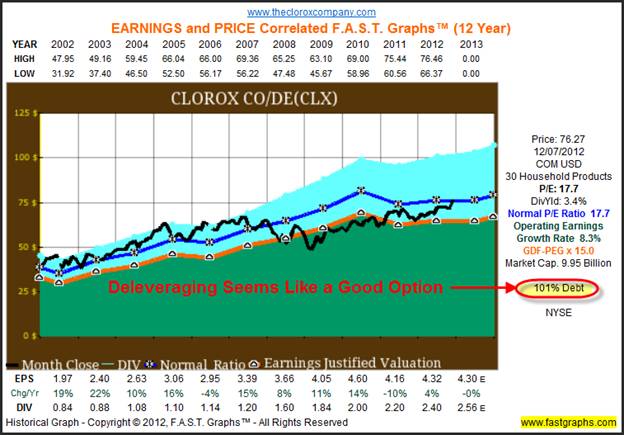
In contrast to Clorox & Co., Accenture PLC (ACN) is currently paying a generous dividend, and has the luxury of no long-term debt. Obviously, this company has no reason to consider the deleveraging option.
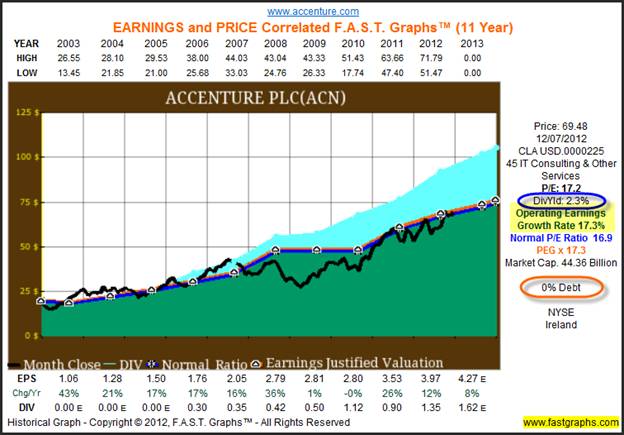
Fund Organic Investments (reinvest in the business)
Very fast-growing companies are typically very capital hungry. In other words, they need to use the vast majority of their earnings and cash flows to fund their rapid growth. Consequently, it is very common to see high growth companies not pay a dividend. Therefore, funding organic growth is arguably the best use of their earnings and cash. This is especially true if the company’s capacity to produce its goods or services is lower than the potential future demand for their products or services. Logically, companies in this situation need to increase their capacity in order to meet future demand and exploit their full profit potential.
On the other hand, if a profitable corporation, perhaps one that operates in a small niche, has excess capacity that exceeds the demand for their products or services, it would make no sense for them to continue to invest to create greater capacity. Companies in this situation might be best served to return profits to shareholders via either dividends or share buybacks (both will be covered later).
The moral of the story is that the company should only continue to invest in its own business when it makes sense for them to do it. Management needs to be certain that any reinvestment they make will provide returns that at least match what they are currently earning, or even better, exceed it. The point is that some companies have a very strong need for reinvestment, while other companies can continue to generate profitable growth without reinvestment.
A fast growing, but still relatively small restaurant chain like Buffalo Wild Wings Inc. (BWLD) represents a good example of a fast-growing company that needs to retain and reinvest all of their earnings and cash flows in order to fund future growth. Consequently, it makes sense that this rapidly-growing company does not pay a current dividend.
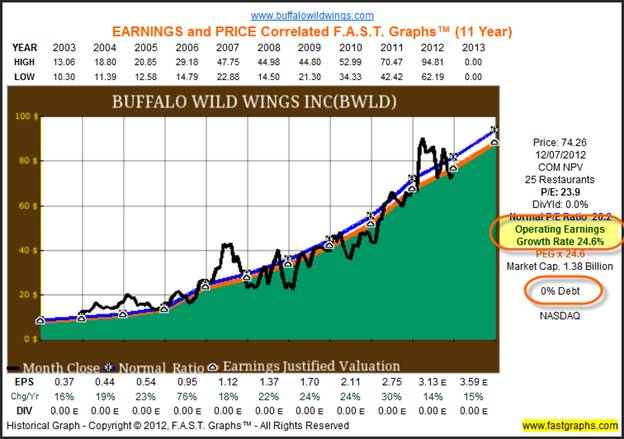
Raven Industries Inc. (RVAN) on the other hand, is a rapidly-growing company that operates in niche industries. The company generates very high revenues per share, which provides them ample cash flows to fund future growth while simultaneously leaving ample cash available to pay regular and special dividends to their shareholders. The following earnings and price F.A.S.T. Graphs™ on Raven Industries shows the numerous special dividends the company has been able to return to shareholders.
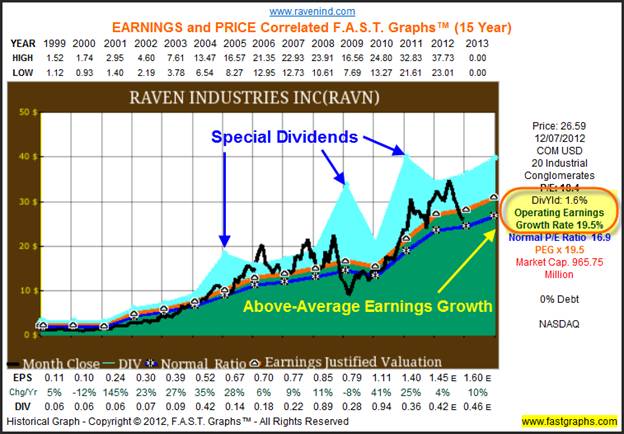
The following three slides from Raven’s annual shareholders meeting in May 2012 illustrate their strong revenue generation, and their modest capital investment needs required to continue funding their rapid growth. Consequently, it would seem risky and maybe even foolish for them to invest their earnings beyond their current capital needs.
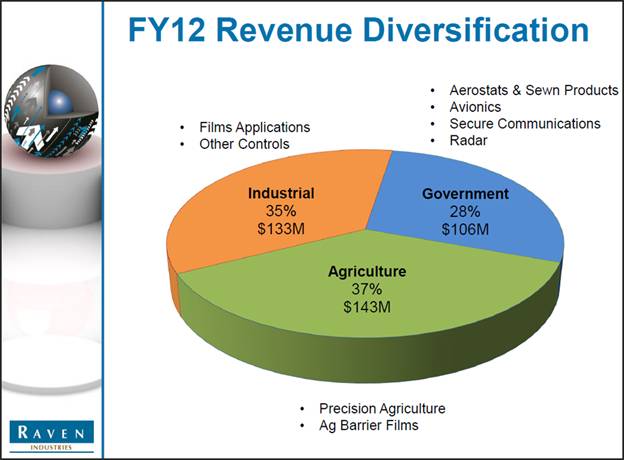
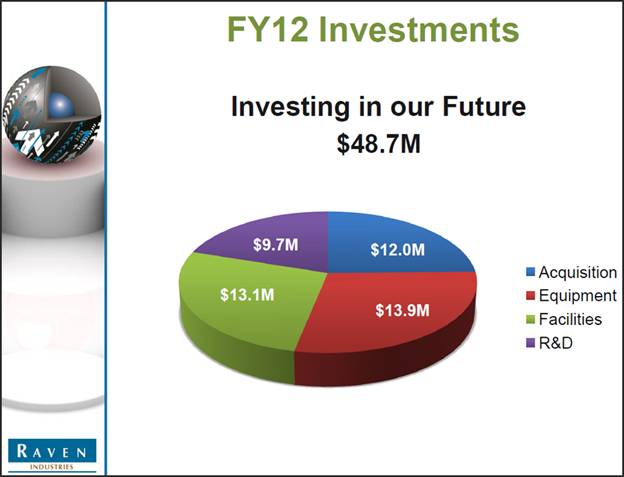
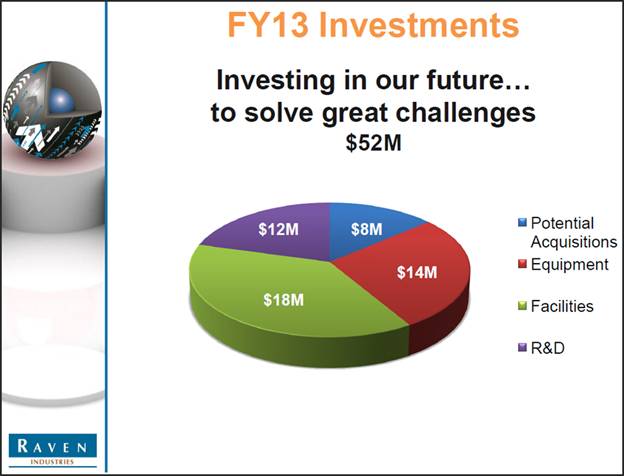
The following excerpt from Raven’s third quarter fiscal 2013 results summarizes their ability to fund growth while simultaneously continuing to reward shareholders with a generous dividend from such a fast-growing company:
“Attractive Cash Position Despite Increased Investments
At October 31, 2012, cash and investment balances were $48.1 million, up from $44.2 million a year ago. Increases in capital expenditures and the $12 million payment to acquire Vista Research, Inc., in the fourth quarter last year were offset by cash flows from operations. The company paid $3.8 million in dividends to shareholders ($0.105 per share) during the quarter. Accounts receivable increased to $55.5 million compared with $50.7 million at October 31, 2011. Inventories were $50.0 million, up from $49.9 million one year earlier. Average accounts receivable days outstanding increased year-over-year while inventory turns declined slightly. Nine-month operating cash flows increased to $58.0 million from $37.7 million in the prior year.”
Pay Dividends
At the most basic level, if a company does not need all of its earnings and cash flow to fund their ability to grow, it is only prudent that they reward their shareholders with a cash dividend payment. Said another way, if the company’s Board and management determine that their business is growing as fast as it can, given the dynamics of their market and size, etc., and therefore, they have excess cash available, it’s only logical for them to pay a dividend to shareholders. Otherwise, they could inadvertently reduce their Return On Equity (ROE) and/or Return On Assets (ROA), thereby actually slowing their growth rate down.
To put this into another perspective, it is very common that mature, very large blue-chip companies find that their growth rates are maxed out as they hit the barrier known as the law of large numbers. Consequently, companies in this situation find that their growth rates will tend to mirror the mean growth of the whole universe. When this occurs, their ability to sustain an above-average rate of growth hits a wall. Consequently, in order to attract and maintain shareholders’ interests, it is very common for them to establish a generous dividend policy with their excess cash. By doing this, they can provide their shareholders a return that is greater than their earnings growth rate (see the links to our previous articles in the introductory paragraph).
The point is that when a company pays a dividend, that action allows it to compete more effectively against faster growing companies that pay no dividends. There are many investors, especially those in retirement or close to it, that are looking for income producing investments to either fully fund or augment their income. Dividend growth stocks with a long legacy of increasing their dividends each year provide a very attractive option for the income seeking investor. Today, not only are dividends competitive, and in many cases superior to fixed income yields, the fact that they provide the shareholder a raise each year sweetens the pot even more. David Fish provides a terrific resource for dividend growth investors with his CCC lists of dividend Champions, Challengers and Contenders which can be found here.
There are a lot of arguments against dividends based on taxation, and other issues, that suggest the notion that the company would be better served not to pay them. However, one practical point that these arguments often ignore is the idea of the return of capital. If you invest in a dividend paying stock, each time you receive a dividend, you are in practical terms, receiving a return of your original capital investment. Not a return on, but a return of your original capital. Although technically this doesn’t reduce your cost basis for tax purposes, etc., it does reduce the true amount of capital you now have at risk. A good dividend growth stock can return a third to half or more of your original investment in cash dividends in a decade’s time.
The following performance report on McDonald’s (MCD) since December 31, 2002 shows that in addition to growing shareholder assets over five-fold, it paid out over 96% of shareholder’s original one thousand dollar investment in cash. Consequently, a buy and hold investor that bought and held McDonald’s over that time would now have the majority of their original investment paid back in cash. Admittedly an extreme example, but it tells the story of a true benefit from receiving cash dividends.
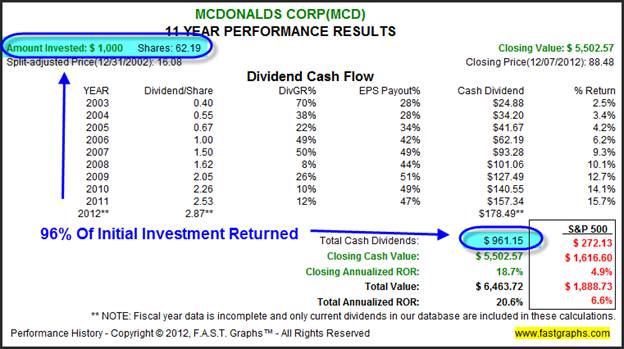
Fund Acquisitions
Making acquisitions can be a terrific source of corporate cash, or an unmitigated disaster. Therefore, whether or not acquisitions make any sense depends on the situation and the company making the acquisition. The following earnings and price correlated graph and performance table on Danaher Corp. (DHR) represents an example of a very successful serial acquirer. This company has grown by acquisition, and has what I believe one of the most competent management teams capable of integrating new businesses under what they call the Danaher Business System (DBS). The following summary taken directly from their website summarizes their skill sets nicely:
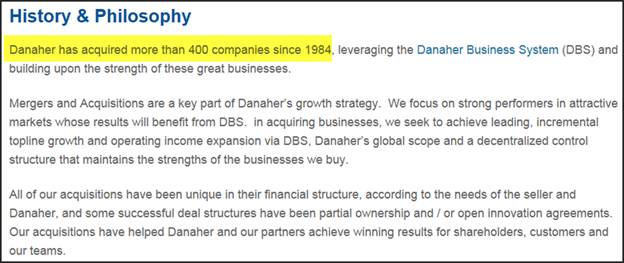
Danaher’s long-term record of growth and shareholder performance validates their corporate strategy and culture. Note that although they do pay a dividend, it is extremely modest.
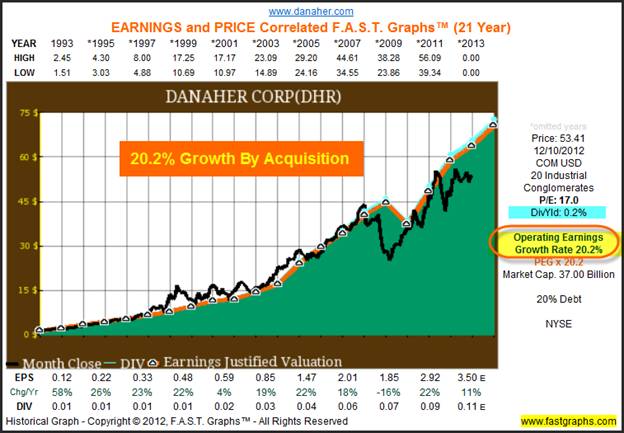
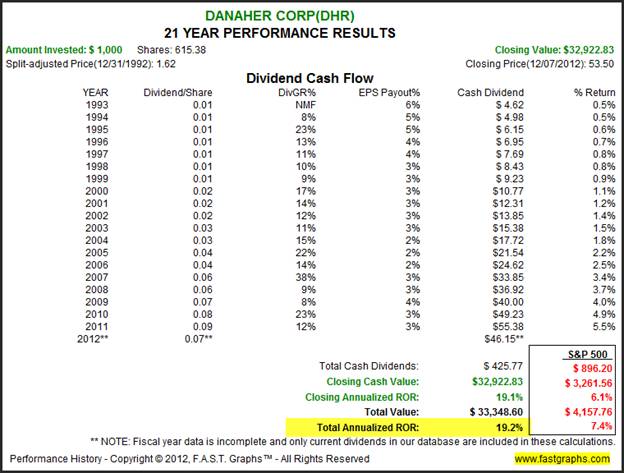
In contrast, a quick review of Hewlett-Packard’s (HPQ) recent history of acquisitions tells an entirely different story. Not only have many of their recent acquisitions hurt the company’s earnings growth, they have generated devastating consequences on the stock price. Although the jury is still out on others, acquisitions such as the disastrous Autonomy transaction in 2011, has been very costly.
This first graphic reviews the long-term results of Hewlett-Packard’s biggest acquisitions. Note the effect that they had on earnings per share (the orange line on the graph).
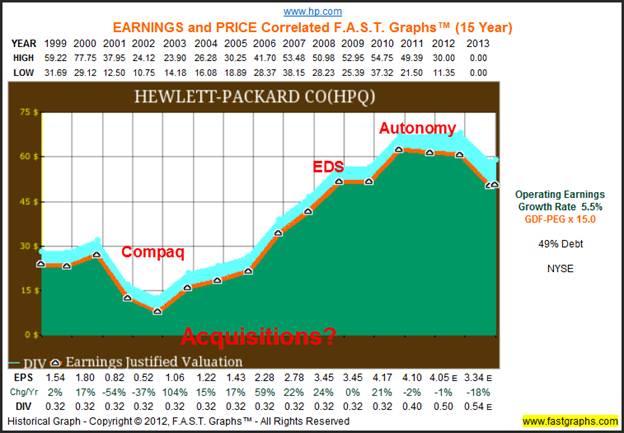
The second graphic looks at Hewlett-Packard’s most recent acquisitions, to include the disastrous Autonomy transaction which led to an $11 billion write-off so far. Therefore, while acquisitions have been very kind to Danaher Corp’s shareholders, the same cannot be said for the shareholders of Hewlett-Packard Corp.
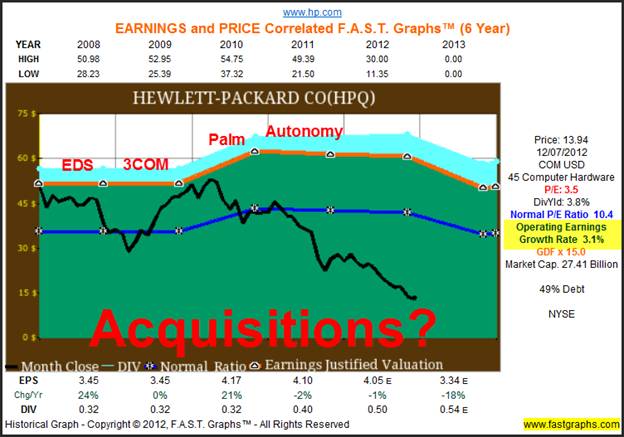
Share Buybacks
Share repurchase or buyback programs are the final option in the pecking order of how a company can use its cash, and is often very controversial. However, I believe there is really no need for controversy here. Share repurchases can be analyzed very simply, if you have the right tools. However, it should also be pointed out that management often has an overly-optimistic view of their company’s intrinsic value. So simply stated, buybacks can be good for shareholders when share prices are low. Conversely, buybacks can be very bad when prices are high.
To my way of thinking, determining whether a company should buy back their shares or not is no different than me deciding whether I should invest in their shares. If the company’s share price is low enough and its earnings growth potential high enough that it represents a high future investment return with low valuation risk, then buying back shares may make a lot of sense for management, just as investing in the shares make sense to me. This is especially true if the company does not have any more attractive options imminently available to them.
For example, Intel Corp. (INTC) recently announced that they are selling notes in order to finance a large share buyback program. As a shareholder, I believe this makes a great deal of business sense considering how undervalued I believe Intel shares are. Intel generates very high levels of operating cash and free cash flow, which we define as Net Cash Flow minus Cash Dividends minus Capital Expenditures. The following graphic reveals Intel’s cash flow prowess.
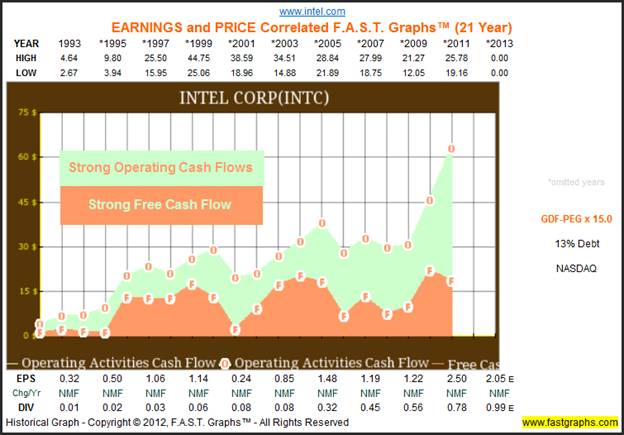
The earnings and price correlated graph on Intel with dividends makes a strong case that the shares are not only historically undervalued, but also undervalued based on intrinsic valuation. Consequently, I believe that Intel’s desire to buy back a large amount of their shares is a very prudent use of shareholder capital currently.
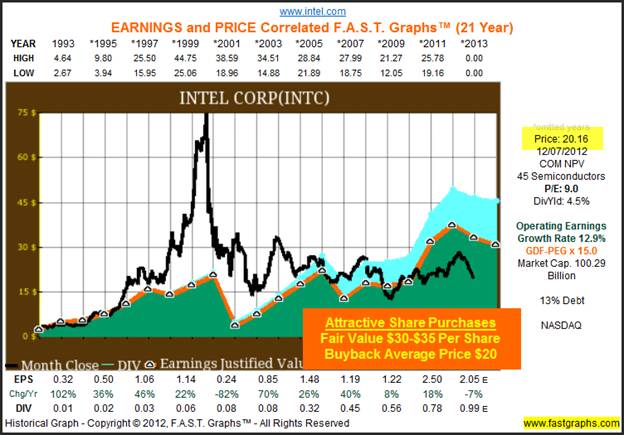
I believe that Intel’s intrinsic value is $30-$35 per share; therefore, the following report on their recent buyback activity which shows an average purchase price of approximately $20 per share seems like a very attractive use of capital:
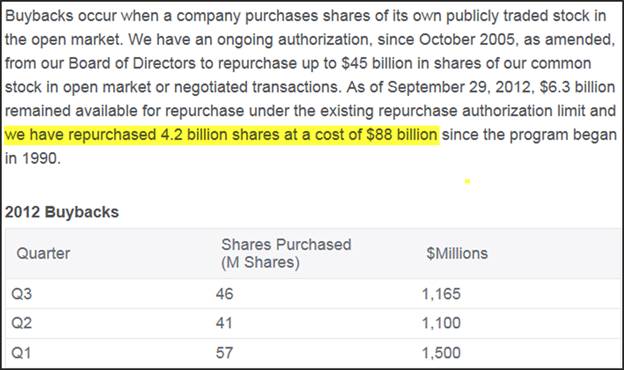
In contrast to the attractiveness of Intel share buybacks, I think the current aggressive share buyback program of Costco Wholesale Corp. (COST) is an imprudent use of their corporate cash. I believe their shares are significantly overvalued (fair value $67, current price $98) in the marketplace today, and therefore, if I were a shareholder I would not be comfortable with this utilization of their cash. Instead, I would much prefer a more generous dividend.
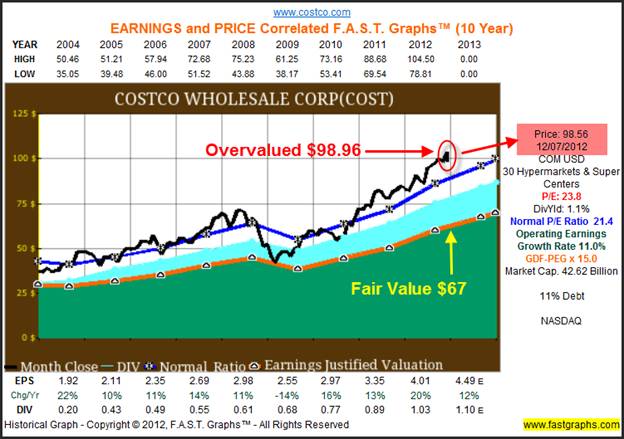
Summary and Conclusions
Corporations have numerous options and uses for the profits they generate. However, there is no right option that applies in all situations. The decision of what a corporation should do with its excess earnings and cash flows depends on the company’s management and board carefully assessing all of the options before them. Sometimes the best use is to invest all of its excess cash directly in itself, other times it might make more sense to pay dividends or buy back shares. Strategic acquisitions can also be a good use of corporate earnings and cash. However, none of these options apply at all times and in all cases.
On the other hand, very large multinational blue-chip companies facing average long-term prospects for growth often find that paying a dividend is a very attractive and important option with which to reward shareholders by. Many investors prefer investing in dividend paying stocks and eschew investing in a company that doesn’t pay one. Moreover, these income seeking investors tend to be long-term shareholders that trade infrequently. Perhaps this explains why many of the blue-chip dividend paying stocks has a very low beta. Lower volatility would seem to be the trait of a company that has a very low turnover of its shares. Corporate management and boards would certainly favor less volatility with their shares.
Therefore, at the end of the day investors must rely on the integrity and skills of the management teams running their respective companies to make the proper decisions regarding capital allocation. Furthermore, in many, if not the large majority of cases, the correct capital allocation decisions will often be a blend of the many options available. In other words, many companies will pay a dividend, buy back shares, commit to capital expenditures (CAPEX), pay down debt, and even make acquisitions all at the same time. And at other times, the same companies may only engage in a few of these capital allocation options at any given point in time. The decisions should always be based on management’s judgment of what the best use of their capital for the benefit of their shareholders would be.
Disclosure: Long CLX, MCD, HPQ and INTC at the time of writing.
By Chuck Carnevale
Charles (Chuck) C. Carnevale is the creator of F.A.S.T. Graphs™. Chuck is also co-founder of an investment management firm. He has been working in the securities industry since 1970: he has been a partner with a private NYSE member firm, the President of a NASD firm, Vice President and Regional Marketing Director for a major AMEX listed company, and an Associate Vice President and Investment Consulting Services Coordinator for a major NYSE member firm.
Prior to forming his own investment firm, he was a partner in a 30-year-old established registered investment advisory in Tampa, Florida. Chuck holds a Bachelor of Science in Economics and Finance from the University of Tampa. Chuck is a sought-after public speaker who is very passionate about spreading the critical message of prudence in money management. Chuck is a Veteran of the Vietnam War and was awarded both the Bronze Star and the Vietnam Honor Medal.
© 2012 Copyright Charles (Chuck) C. Carnevale - All Rights Reserved Disclaimer: The above is a matter of opinion provided for general information purposes only and is not intended as investment advice. Information and analysis above are derived from sources and utilising methods believed to be reliable, but we cannot accept responsibility for any losses you may incur as a result of this analysis. Individuals should consult with their personal financial advisors.
© 2005-2022 http://www.MarketOracle.co.uk - The Market Oracle is a FREE Daily Financial Markets Analysis & Forecasting online publication.



